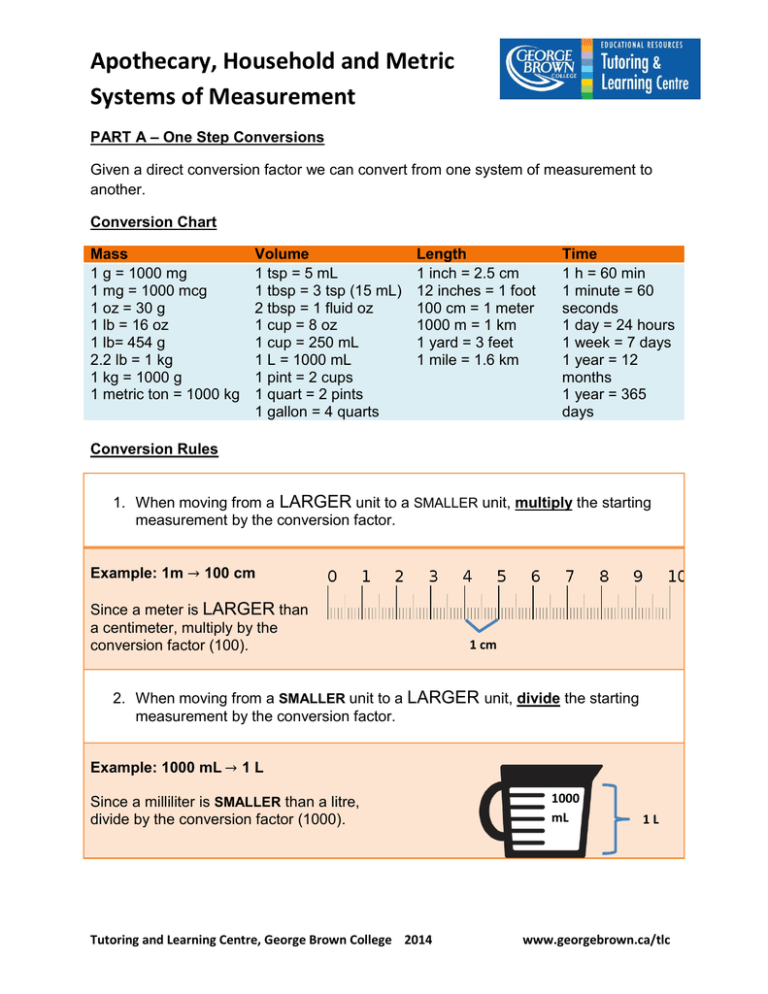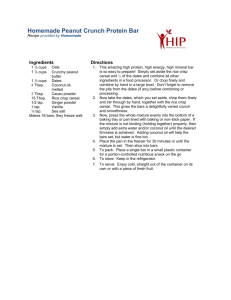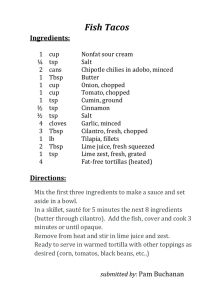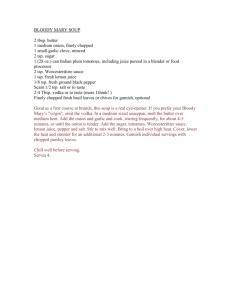Apothecary, Household and Metric Systems of Measurement
advertisement

Apothecary, Household and Metric Systems of Measurement PART A – One Step Conversions Given a direct conversion factor we can convert from one system of measurement to another. Conversion Chart Mass 1 g = 1000 mg 1 mg = 1000 mcg 1 oz = 30 g 1 lb = 16 oz 1 lb= 454 g 2.2 lb = 1 kg 1 kg = 1000 g 1 metric ton = 1000 kg Volume 1 tsp = 5 mL 1 tbsp = 3 tsp (15 mL) 2 tbsp = 1 fluid oz 1 cup = 8 oz 1 cup = 250 mL 1 L = 1000 mL 1 pint = 2 cups 1 quart = 2 pints 1 gallon = 4 quarts Length 1 inch = 2.5 cm 12 inches = 1 foot 100 cm = 1 meter 1000 m = 1 km 1 yard = 3 feet 1 mile = 1.6 km Time 1 h = 60 min 1 minute = 60 seconds 1 day = 24 hours 1 week = 7 days 1 year = 12 months 1 year = 365 days Conversion Rules 1. When moving from a LARGER unit to a SMALLER unit, multiply the starting measurement by the conversion factor. Example: 1m 100 cm Since a meter is LARGER than a centimeter, multiply by the conversion factor (100). 1 cm 2. When moving from a SMALLER unit to a LARGER unit, divide the starting measurement by the conversion factor. Example: 1000 mL 1L Since a milliliter is SMALLER than a litre, divide by the conversion factor (1000). Tutoring and Learning Centre, George Brown College 2014 1000 mL 1L www.georgebrown.ca/tlc Apothecary, Household and Metric Systems of Measurement Example 1: Convert 5 cups into mL. Step 1: Find the conversion factor between our starting measurement and our desired unit. Looking at our conversion chart we notice that 1 cup = 250 mL . Step 2: Since we are moving from a LARGER unit to a SMALLER unit, multiply the starting measurement by the conversion factor and simplify. Thus, there are 1250 mL in 5 cups. Example 2: Convert 154 lb into kg. Step 1: Find the conversion factor between our starting measurement and our desired unit. Looking at our conversion chart we notice that 2.2 lb = 1 kg . Step 2: Since we are moving from a SMALLER unit to a LARGER unit, divide the starting measurement by the conversion factor and simplify. Thus, there are 70 kg in 154 lb. PART B – Multi-Step Conversions In some cases, we may not have a direct conversion factor. To convert from one unit of measure to another, we have to bridge together multiple conversions. Example 3: Convert 65 in into m. Step 1: Find the conversion factor between our starting measurement and our desired unit. Since there isn’t a direct conversion from in to m, we are going to break the conversion into two steps. a) inch cm Tutoring and Learning Centre, George Brown College 2014 b) cm m www.georgebrown.ca/tlc Apothecary, Household and Metric Systems of Measurement Step 2: In part a) our conversion factor is 1 in = 2.5 cm . Since we are moving from a LARGER unit to a SMALLER unit, multiply the starting measurement by the conversion factor and simplify. Step 3: In part b) our conversion factor is 100 cm = 1 m . Since we are moving from a SMALLER unit to a LARGER unit, divide the starting measurement by the conversion factor and simplify. Thus, there is 1.625 m in 65 in. Example 4: Convert 5.2 L into tsp. Step 1: Find the conversion factor between our starting measurement and our desired unit. Since there isn’t a direct conversion from L to tsp, we are going to break the conversion into two steps. a) L mL b) mL tsp Step 2: In part a) our conversion factor is 1 L = 1000 mL . Since we are moving from a LARGER unit to a SMALLER unit, multiply the starting measurement by the conversion factor and simplify. Step 3: In part b) our conversion factor is 5 mL = 1 tsp . Since we are moving from a SMALLER unit to a LARGER unit, divide the starting measurement by the conversion factor and simplify. Thus, there is 1040 tsp in 5.2 L. Tutoring and Learning Centre, George Brown College 2014 www.georgebrown.ca/tlc Apothecary, Household and Metric Systems of Measurement NOTE: There are other methods of converting between different systems of measurement. For alternative methods, see “Dimensional Analysis” or “Conversions in the Metric System” TLC hand-outs. Exercises: Convert between the apothecary, household and metric systems of measurement. 1) 4 tsp (into mL) = 2) 5 oz (into g) = 3) 2 cups (into mL) = 4) 400 mL (into L) = 5) 8 tbsp (into ml) = 6) 450 g (into oz) = 7) 12 in (into cm) = 8) 200 lb (into kg) = 9) 197 in (into m) = 10) 650 mL (into cups) = 11) 30 ml (into tbsp.) = 12) 5 kg (into lb) = 13) 3 m (into in) = 14) 5 tbsp (into fluid oz ) = 15) 5 feet 3 in (into m ) = 16) 5 m (into feet and inches) = 17) 5.2 L (into tsp) = 18) 1600 mg (into oz) = 19) 60 mL (into tbsp) = 20) 2 tbsp (into tsp) = Solutions: 1) 20 mL (1 tsp = 5 mL) 3) 650 mL (1 cup = 250 mL) 5) 120 mL (1 tbsp = 15 mL) 7) 30 cm (1inch = 2.5 cm) 9) 4.925 m (1 inch = 2.5 cm; 100 cm = 1 m) 2) 150 g (1 oz = 30 g) 4) 0.4 L (1000 mL = 1 L) 6) 15 oz (30 g = 1 oz) 8) 90.9 kg (2.2 lb = 1 kg) 10) 2.6 cups (250 mL = 1 cup) 11) 2 tbsp (15 mL = 1 tbsp) 13) 300 cm = 120 in (2.5 cm = 1 inch) 12) 11 lb (1 kg = 2.2 lb) 14) 2.5 fluid oz (2 tbsp = 1 fluid oz) 15) 63 inches = 157.5 cm = 1.575 m (1 foot = 12 inches; 1 inch = 2.5 cm) 16) 500 cm = 200 inches = 16’8” (1 m = 100 cm; 2.5 cm = 1 inch; 12 inches = 1 foot) 18) 1.6 g = 0.053 oz (1000 mg = 1 g; 30 g = 1 oz) 20) 7 tsp (1 tbsp = 3 tsp) 17) 5200 mL = 1040 tsp (1L = 1000 mL; 5 mL = 1 tsp) 19) 4 tbsp (15 mL = 1 tbsp) Tutoring and Learning Centre, George Brown College 2014 www.georgebrown.ca/tlc


